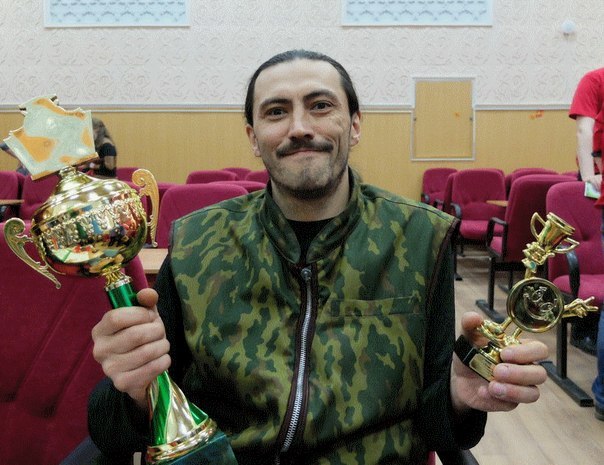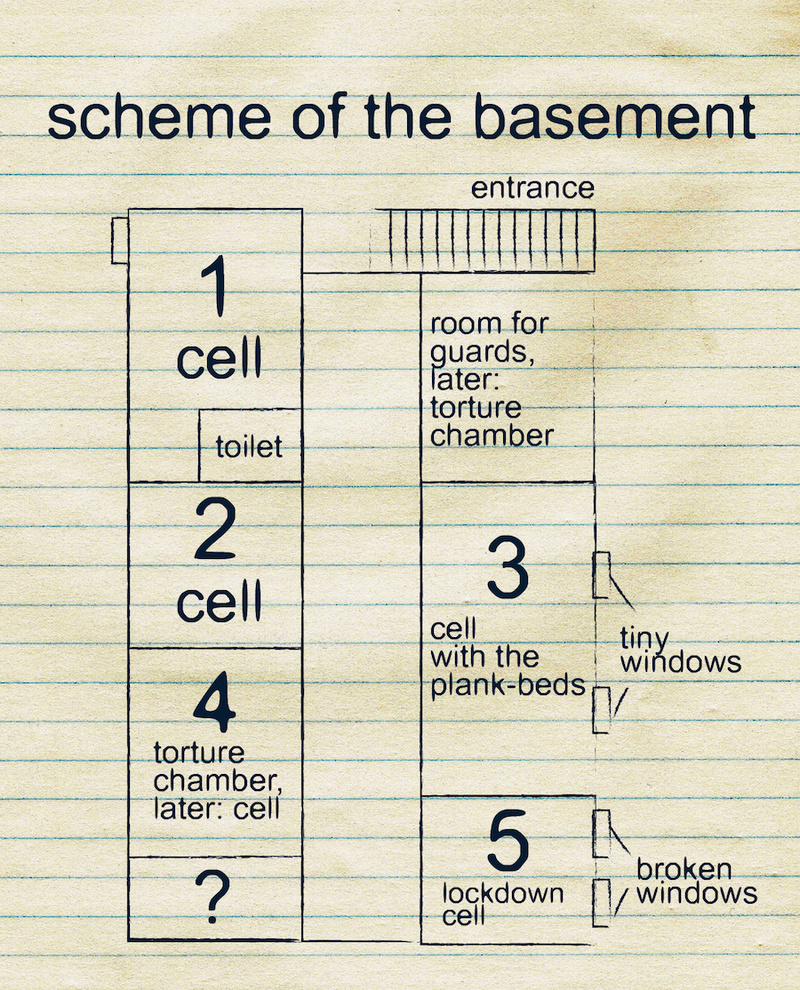
[Dahl University, main building; Batman group headquarter, building no. 4 with the basement prison]
In June 2014, fighters of the so-called ‘Batman rapid response team’ led by Oleksandr Byednov settled in the dormitories of Volodymyr Dahl East Ukrainian National University, also known as ‘Mashinstytut’. According to eyewitnesses, students were given 15 minutes to move out. They escaped leaving their clothes, equipment, food, and even documents behind. The militants later used these things and ordered prisoners to take better furniture and equipment to militants’ rooms.
‘We didn’t manage to take [our] things and ended up outside in shorts and home slippers. I went out to do some shopping, and when I came back, it turned out I had become homeless. Luckily, it was summer, and I had all the money and documents on me. I went back to my parents in Melovoe wearing my home clothes’, one of the students told Fakty newspaper.
The jail, known as the ‘temporary detention facility’, was located in the basement of a nine-storey dormitory building no. 4 (Molodizhny quarter 20A). It became one of the most notorious basements in Donbas after Ihor Plotnysky’s men had shut it down and launched a campaign in the ‘LPR’ media to expose the atrocities committed by their rivals.
People were taken to the basement for various reasons, including denunciations by neighbours, alleged pro-Ukrainian views, alcohol consumption, curfew violations, attempts to force them to give away cars or apartments, internal conflicts as well as being too tanned, giving an odd look, a black-and-white passport photo, or going to a garden plot (‘possibly to adjust hostile fire’). A young man was in detention for a month for throwing a firecracker and scaring the neighboring elderly ladies. Oleksandr, a separatist patrol member, nicknamed ‘Tsyrkul’ (‘Compasses’), and his neighbor were jailed for daring to stop the Batman’s car; both were beaten to half death. There were 50-80 prisoners held in the basement simultaneously, and, overall, hundreds of people had been there.
During six months of its functioning, the basement was run by individuals like ‘Phobos’, then ‘Dak’, then ‘Luis’, and, finally, ‘Subota’. One of the leaders, Ihor ‘Luis’ Tsykunov, came to Donbas from Magadan (Russia) in July 2014. He posted his heroicized narrative of the ‘struggle against fascism’, an analysis of the failure of the victorious advance on Kyiv, the reasons for failing to build the ‘little Switzerland’ in the ‘LPR’, as well as recollections of participating in torture ‘in the basement’, on his page in VKontakte.

Igor Tsikunov aka Luis
Prisoners were held in four rooms. The first, large one, could hold up to 30 people, men and women, who were ‘not expected to cause trouble’. It was the only room with toilet facilities. The prisoners were sleeping on mattresses on the concrete floor. The second cell was smaller and had worse conditions. When prisoners lay down to sleep, they took up the entire floor. Approximately 20 people, both men and women, were held there. Women were taken to use the toilet in the first room, while men used a bucket in front of women. It was the least ventilated room, and there were no windows. If the door was closed, people would not be able to breathe in half an hour. If the door was open, there was strong draft. ‘Luis’ recalls with pity how the hallway guard always had a cold.
In the third cell, there were approximately 25 people. The militants called it a VIP cell since it was equipped with ‘plank-beds’, i.e. door panels placed on racks. The fourth cell used to be a torture chamber. When the number of prisoners had increased, it was transformed into a cell for holding people, while torture took place in the guards’ room. The fifth cell was used for solitary confinement. It had two broken windows, and it became extremely cold in the fall, which led to at least one reported death. Overall, the basement was very humid, and water was dripping down the pipes due to condensation. The cells were very hot in the summer, while people were freezing in the fall.

Layout of the basement (according to the victims) - entrance, 1 - cell, 2 - cell, 3 - cell w/plank-beds, 4 - cell, torture chamber, 5 - solitary confinement cell, guards' room (later - torture chamber), basement windows, broken windows
Prisoners received water in plastic bottles twice a day. They were fed twice, in the afternoon and at midnight. The meals were a bowl of pearl barley, buckwheat, or barley groats, often unsalted. For prisoners in certain cells, the food was deliberately left in the draft to cool. People had no means to wash themselves. There was no regular medical care. As a rule, a nurse came once in a few days to dress gunshot wounds. Moreover, some doctors helped the torturers by bringing round the victims so that the torture could be resumed.
In addition, two people were held in the basement of a five-storey building next door where Batman fighters had their headquarters and warehouses. One of the prisoners had said he had AIDS, and they decided to isolate them both. According to one of the victims,
‘Those two … were held like cattle, in terrible conditions… There was no light. They only had stuff to drink since there were water supply and heating pipes in the basement. They had no toilet facilities, and had to dig holes, cover them, and dig new ones’
‘Luis’, ‘Hohol’, ‘Phobos’ and others were engaged in torture. Often, they started ‘disciplinary education’ with the newcomers right in the hallway. However, former prisoners were most horrified by the staff torturer Serhiy Konoplytsky with a speaking nickname ‘the Maniac’. Allegedly, his favourite tool was a polyurethane planishing hammer. However, ‘the Maniac’ had an entire collection of tools, including plastic pipes with heavy filling, an axe, a stun gun, and a surgical set. For instance, a survivor talked about ‘the Maniac’ cutting the web between fingers with a surgical saw.

Staff torturer Serhiy ‘Maniac’ Konoplytsky
The torture house was operating at all times, especially in the evening and during the night. The screaming never stopped. Some people were used as punching bags for practice. During nighttime torture, people in the cell opposite the torture chamber stayed awake as the ‘Maniac’, overwhelmed by power, often ran in to grab the next victim.
Local media published a story of a woman and her mother who had been taken to the basement with the aim of forcing her to give her house to the Batman. The story mentions ‘the Maniac’ and his role, ‘When prisoners were in jail, S.S. Konoplytsky (nickname ‘the Maniac’) used moral coercion; he threatened to cut the skin off their faces and murder them if they would not give the property to A.A. Byednov’
Some prisoners were beaten to death. For instance, there were three men in the basement who had joined the ‘militia’ and got severely intoxicated on this occasion. In the cell, one of them stated that, he’d actually joined for his son and was supporting Ukraine. He was then taken to the torture chamber. Half-conscious, he was brought back to the cell. ‘Hohol’ jumped on his chest, his ribs cracked, and the man died shortly after. They wrapped him in a carpet and threw his body outside the city.
‘Luis’ refers to another case of death in the basement in his memoirs,
‘Once, our patrol took an old man for drinking and debauchery following a complaint. He was absolutely mad and violent, and we handcuffed him and threw into the fifth until he would return to normal. On the following day, he had delirium tremens, was moaning, shouting, attacking, and not eating. We found his cold body on the following day’
And here is one of eyewitness accounts of the story:
‘He was 86 years old. He could not walk unassisted… For him to defecate in the bucket, we had to hold him… The old man was hit with a buttstock in the nose, and they also beat him up. They brought him in his underpants and continued to keep him like that in the basement… There were no mattresses on the concrete floor, only some synthetic cloth. It was already quite cold… He died from beatings, cold, and old age. The old man was lying or sitting on the floor all the time. We were also cold, but we were walking, moving. First, he stopped eating. He refused to eat the prison food. The next day … we were not able to wake him up for lunch’
‘Do not think that the basement had some gloomy Gestapo atmosphere. People happily went to work’, says ‘Luis’.
Former prisoners reported that work was indeed an easier challenge than sitting in the basement for days on end. ‘It was hard to sit in the basement and listen to the sounds of torture. Moreover, if you stayed when everyone had gone to work, you had to wash the blood of the walls and the floor after torture sessions’, says one of the victims.
Nevertheless, it was hard work. Prisoners had to dig trenches, repair equipment, build barricades, load sandbags etc. The Batman’s basement supplied slaves following requests from different units. Some groups, including ‘Hooligan’s’ or ‘Night Wolves’ treated prisoners more humanely. For instance, they gave food, tea and cigarettes, allowed prisoners to wash themselves, use a washing machine and take a rest after work before returning to the horrors of the basement. Work in other units, such as the neo-Nazi unit ‘Rusychi’, turned into hell: the prisoners were beating, they had nothing to eat or drink and were not allowed to pause or even work slower.
‘The very fact of the widespread use of slave labour in all sectors of the response team’s activities was shocking. People were not ashamed to use prisoners for all the dirty and heavy work, from cleaning and digging trenches to cooking’, Yevhen Serheyev, a Russian member of the Batman’s group who returned to Russia after six months with the group, posted in VKontakte.
On 13 November 2014, forces under Plotnysky’s command liberated the prisoners, however, continued keep them in that basement for a few more months, allegedly, for their own safely. Several members of the Batman’s gang were captured and jailed. On 1 January 2015, Batman was killed.

Photo: Suspilne On September 15, human rights activists held campaigned near the Verkhovna Rada of Ukraine requesting adopton of the...

53% of Ukrainians believe that only those persons whose guilt in war and other serious crimes will be proven in court should be pros...

More than 100 mercenaries from more than 30 countries are fighting on the side of illegal armed groups in Donbass. Deputy Prosecutor...
The Secretariat of the Coalition «Justice for Peace in Donbas»
04060, Kyiv, Ryzhska str., 73 G